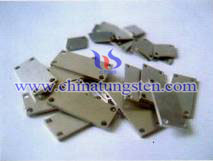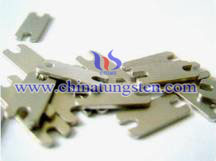Tungsten Copper Heat Sinks
Tungsten copper heat sinks is a term for a component or assembly that transfers heat generated within a solid material to a fluid medium, such as air or a liquid. Examples of heat sinks are the heat exchangers used in refrigeration and air conditioning systems and the radiator (also a heat exchanger) in a car. Heat sinks also help to cool electronic and optoelectronic devices, such as higher-power lasers and light emitting diodes (LEDs).


A heat sinks uses its extended surfaces to increase the surface area in contact with the cooling fluid, the air for example. The term is not meant literally, as a heat sinks does not have a "magical ability to absorb heat like a sponge and send it off to a parallel universe". Heat transfer theory helps explain practical aspects of how heat sinks work, and can also help to clear up common misconceptions and design mistakes. Approach air velocity, choice of material, fin (or other protrusion) design and surface treatment are some of the design factors which influence the thermal resistance, i.e. thermal performance, of a heat sink. One engineering application of heat sinks is in the thermal management of electronics, often computer CPU or graphics processors. For these, heat sink attachment methods and thermal interface materials also influence the eventual junction or die temperature of the processor(s). Theoretical, experimental and numerical methods can be used to determine a heat sink's thermal performance.
Tungsten copper high performance composites are fabricated from carefully controlled porous tungsten that is vacuum infiltrated with molten copper. This results in a W/Cu composite that has high conductivity and a matched low thermal expansion for heat sinks.It is a composite of tungsten and copper. By controlling the content of tungsten, we can design its coefficient of thermal expansion (CTE), matching that of the materials, such as Ceramics (Al2O3, BeO), Semiconductors (Si), Kovar, etc.
Tugnsten Copper Heat Sinks Advantages
- High thermal conductivity
- Excellent hermeticity
- Excellent flatness, surface finish, and size control
- Semi-finished or finished (Ni/Au plated) products available
Heat sinks are used to conduct heat away from computer chips and integrated circuits, preventing thermal damage. Depending on the electronic device, heat sinks come in different sizes and shapes. Tungsten-copper composites, with copper content (by weight) of 15 to 20 percent, are often used to make heat sinks. Our products are widely used in applications such as optoelectronics packages, Microwave Packages, C Packages, Laser Submounts, etc.
Tugnsten Copper Heat Sinks Technical Data
Type |
Composition |
Properties |
||
|
Tungsten Content |
Density |
CTE |
Thermal Conductivity |
W90Cu |
90 ± 1 wt % |
17.0 g/cm3 |
6.5 ppm/K |
180 - 190 W/m.K |
W85Cu |
85 ± 1 wt % |
16.3 g/cm3 |
7.0 ppm/K |
190 - 200 W/m.K |
W80Cu |
80 ± 1 wt % |
15.6 g/cm3 |
8.3 ppm/K |
200 - 210 W/m.K |
W75Cu |
75 ± 1 wt % |
14.9 g/cm3 |
9.0 ppm/K |
220 - 230 W/m.K |
Properties of WCu and MoCu Heat Materials
|
MIM |
Infiltrated |
MIM |
Infiltrated |
Density(g/cm3) |
15.6-16.2 |
16.4 |
9.3-9.5 |
10.0 |
Thermal Conductivity |
180-190 W/mK |
190 W/mK |
140-160 W/mK |
160 W/mK |
Thermal Expansion |
7.2 ppm/K |
7.47 ppm/K |
7.0 ppm/K |
7.0 ppm/K |
Net-Shape Capability |
Excellent |
Sheets Only |
Excellent |
Sheets Only |
Molybdenum copper heat sinks is a composite made from Mo and Cu, Similar to W-Cu, CTE of Mo-Cu can also be tailored by adjusting the composition. But Mo-Cu is much lighter than W-Cu, so that it is more suitable for aeronautic and astronautic applications.
Any feedback or inquiry of Tungsten Copper Alloy Products please feel free to contact us:
Email: sales@chinatungsten.com
Tel.: +86 592 512 9696 ; +86 592 512 9595
